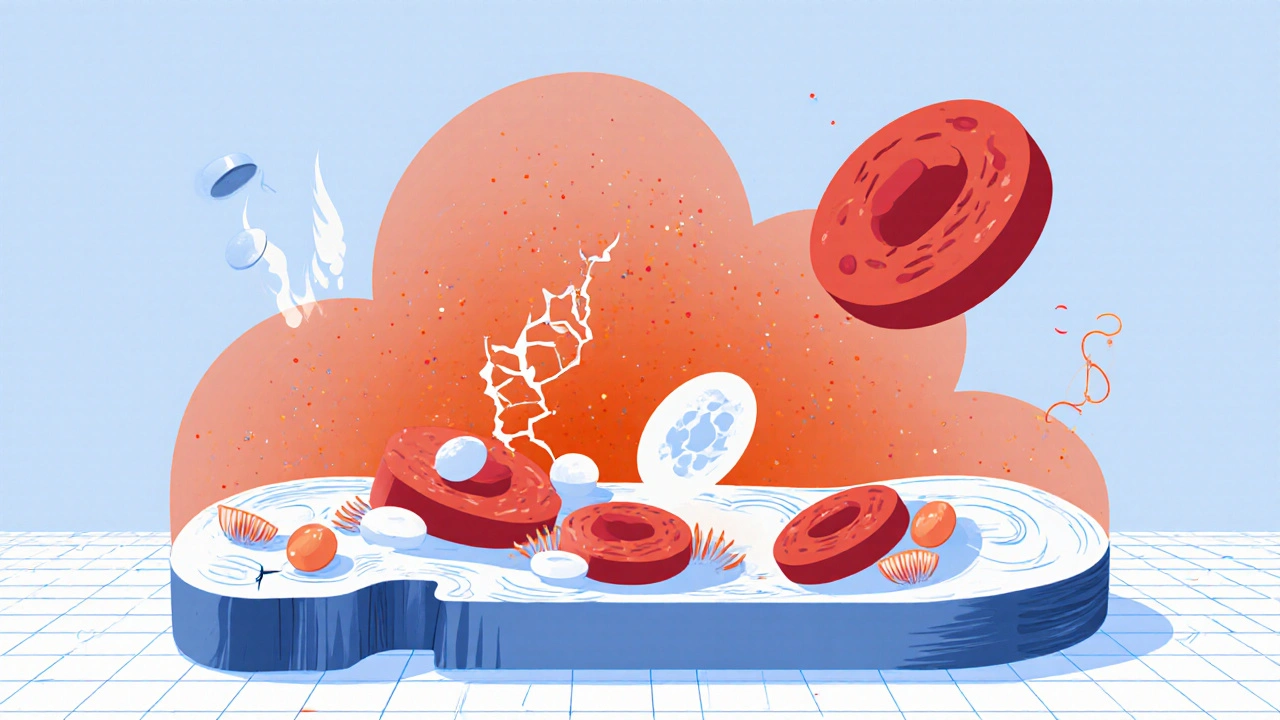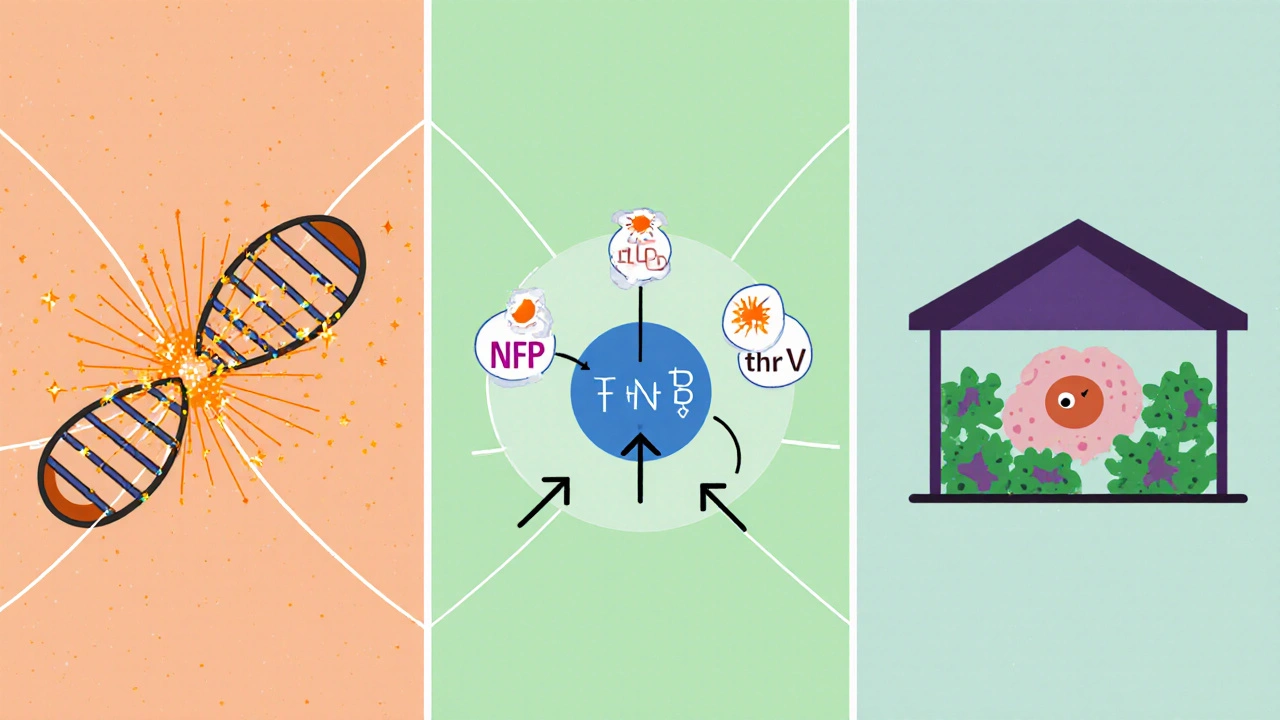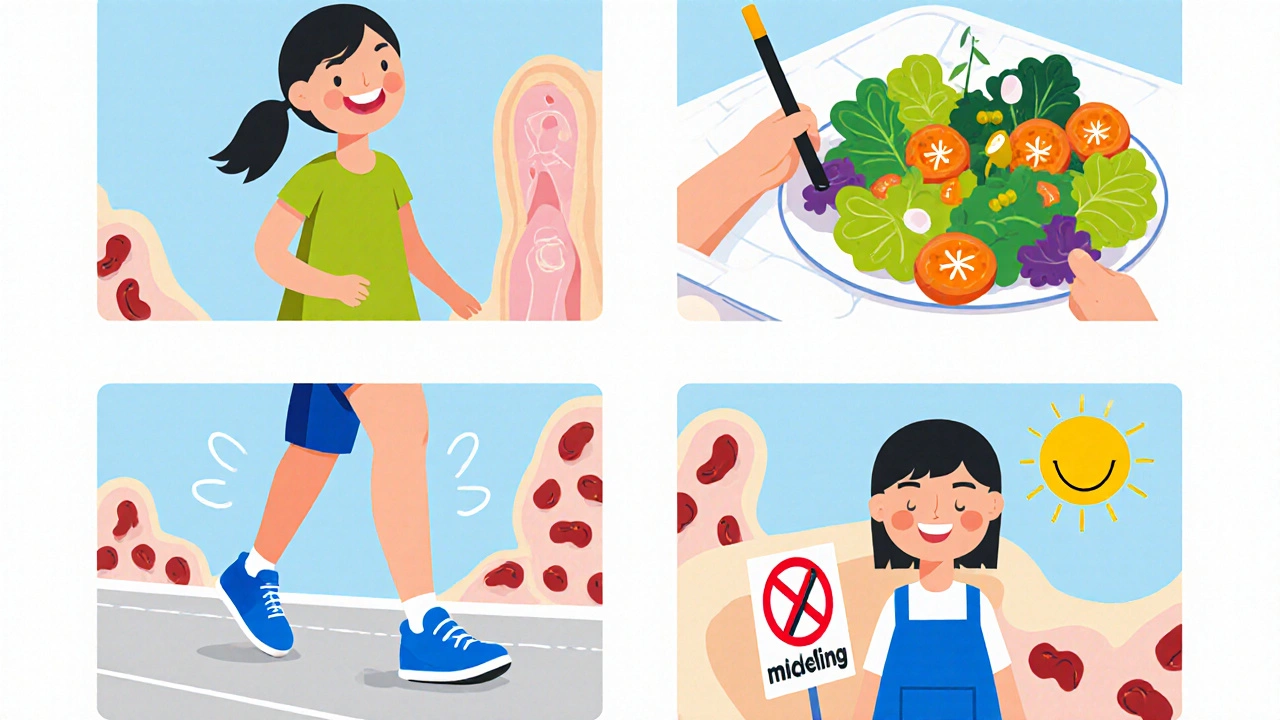
Blood Cancer Risk Calculator
Estimate Your Risk
Risk Assessment
This tool estimates relative risk based on scientific data from the article. It is not a medical diagnosis. Discuss results with your healthcare provider.
When doctors talk about Blood Cancer is a group of cancers that originate in the bone marrow or blood-forming tissues, including leukemia, lymphoma, and multiple myeloma. it’s often framed as a disease of rogue blood cells. Yet many patients and researchers overlook a silent accomplice: Chronic Inflammation is a prolonged, low‑grade activation of the immune system that can last months or years. Understanding how these two concepts intertwine can change how we spot risk, intervene early, and think about treatment.
What Exactly Is Blood Cancer?
Blood cancers fall into three main families:
- Leukemia - uncontrolled growth of immature white‑blood cells in the marrow.
- Lymphoma - malignant transformation of lymphocytes, often forming tumors in lymph nodes.
- Multiple Myeloma - proliferation of plasma cells that crowd out healthy marrow.
All share a common thread: they disrupt the bone marrow’s ability to produce healthy blood cells, leading to anemia, infections, and bleeding problems.
Defining Chronic Inflammation
Inflammation is the body’s natural response to injury or infection. When the stimulus disappears, the response should fade. In chronic inflammation, the signal never fully turns off, keeping immune cells-especially macrophages and neutrophils-on high alert. Common drivers include obesity, smoking, persistent infections, and exposure to environmental toxins.
Biological Bridge: How Inflammation Fuels Cancer
Three intertwined mechanisms link sustained inflammation to blood cancer development:
- DNA Damage - Reactive Oxygen Species (Reactive Oxygen Species are highly reactive molecules that can break DNA strands. Chronic inflammation floods tissues with ROS, increasing the chance of mutations in hematopoietic stem cells.
- Signal‑Pathway Hijacking - Cytokines such as IL‑6 and TNF‑α activate the NF-κB pathway which drives cell survival and proliferation. Simultaneously, the JAK‑STAT signaling cascade amplifies growth signals, giving mutated cells a competitive edge.
- Micro‑environment Remodeling - The Bone Marrow Microenvironment becomes a niche that supports malignant clones. Fibroblasts, stromal cells, and infiltrating immune cells release growth factors that protect cancer cells from chemotherapy.
When these forces align, a single mutated stem cell can expand into a full‑blown blood cancer.

Evidence From Recent Studies
Large‑scale epidemiology gives a clear picture:
- A 2023 cohort of 1.2 million adults found that elevated C‑reactive protein (CRP > 10 mg/L) doubled the risk of developing leukemia over a ten‑year follow‑up.
- Researchers at the University of Sydney reported that patients with long‑standing ulcerative colitis had a 3.5‑fold higher incidence of lymphoma compared with the general population.
- Single‑cell sequencing in 2024 revealed that Clonal Hematopoiesis - a condition where blood‑forming stem cells acquire mutations but haven’t yet turned cancerous - is more common in people with chronic inflammatory diseases such as rheumatoid arthritis.
These data reinforce the notion that inflammation isn’t just a side effect; it’s a driver.
Inflammatory Markers Linked to Specific Blood Cancers
| Marker | Typical Level in Chronic Inflammation | Blood Cancer(s) Most Strongly Correlated |
|---|---|---|
| C‑reactive protein (CRP) | >10 mg/L | Acute Myeloid Leukemia, Chronic Lymphocytic Leukemia |
| Interleukin‑6 (IL‑6) | >7 pg/mL | Multiple Myeloma, Myeloproliferative Neoplasms |
| Tumor Necrosis Factor‑α (TNF‑α) | >20 pg/mL | Non‑Hodgkin Lymphoma, Adult T‑cell Leukemia |
Lifestyle Factors That Can Amplify the Inflammation‑Cancer Loop
Not all inflammation is unavoidable. The following habits have been shown to keep the immune system in check:
- Weight Management - Adipose tissue releases IL‑6 and leptin, both pro‑inflammatory. Losing 5‑10 % of body weight can lower CRP by up to 30 %.
- Smoking Cessation - Tobacco smoke generates ROS and activates NF‑κB. Former smokers see a gradual drop in inflammatory markers after 2‑3 years.
- Balanced Diet - Mediterranean‑style meals rich in omega‑3 fatty acids, nuts, and leafy greens boost anti‑inflammatory mediators like resolvins.
- Regular Exercise - Moderate aerobic activity reduces TNF‑α levels and improves immune surveillance.
- Stress Reduction - Chronic psychosocial stress elevates cortisol, which paradoxically can increase inflammatory cytokine production.
Integrating even a few of these actions can tip the scales away from a hostile marrow environment.

Implications for Diagnosis and Treatment
Because inflammation is measurable, clinicians are beginning to incorporate it into risk‑assessment models.
- Screening - High‑risk groups (e.g., long‑standing autoimmune disease) may undergo periodic blood panels that include CRP, IL‑6, and a complete blood count.
- Targeted Therapies - Drugs such as ruxolitinib (a JAK inhibitor) are already approved for myelofibrosis and are being tested in chronic inflammation‑driven leukemias.
- Anti‑Inflammatory Adjuncts - Low‑dose aspirin, statins, or even dietary omega‑3 supplements are being evaluated as add‑ons to standard chemotherapy to reduce relapse rates.
- Personalized Monitoring - Serial measurement of inflammatory biomarkers can flag early disease transformation in patients with clonal hematopoiesis.
These strategies illustrate a shift from treating blood cancer as a standalone enemy to addressing the whole inflammatory ecosystem that nurtures it.
Take‑Away Checklist
- Know the three main types of blood cancer and their hallmark symptoms.
- Recognize chronic inflammation signs: persistent fatigue, low‑grade fever, unexplained weight gain, or joint pain.
- Request baseline inflammatory labs (CRP, IL‑6) if you have risk factors like obesity or autoimmune disease.
- Adopt anti‑inflammatory lifestyle habits - weight control, smoke‑free living, Mediterranean diet, regular exercise.
- Ask your doctor about emerging treatments that target inflammatory pathways, especially if you are diagnosed with a myeloproliferative neoplasm.
Frequently Asked Questions
Can chronic inflammation cause blood cancer on its own?
Inflammation alone rarely sparks cancer, but it creates a fertile ground for DNA‑damaging events and clonal expansion. When paired with genetic mutations, the risk rises sharply.
Are there specific foods that lower my risk?
Yes. Foods rich in omega‑3 (salmon, flaxseed), antioxidants (berries, leafy greens), and polyphenols (green tea, turmeric) have been shown to dampen IL‑6 and TNF‑α production.
Should I get regular CRP tests if I have a family history of leukemia?
Discuss with your hematologist. While CRP isn’t a definitive cancer screen, persistent elevation combined with other risk factors may prompt earlier bone‑marrow evaluation.
Do anti‑inflammatory drugs interfere with chemotherapy?
Some, like high‑dose NSAIDs, can affect platelet function and kidney clearance of chemotherapeutic agents. Low‑dose aspirin or prescription‑grade anti‑inflammatories are typically managed under oncologist supervision.
Is there a genetic test for inflammation‑driven blood cancers?
Next‑generation sequencing panels now include genes linked to clonal hematopoiesis (e.g., DNMT3A, TET2) and inflammatory pathway mutations (e.g., JAK2). These tests help gauge both cancer risk and potential response to JAK inhibitors.
Understanding that chronic inflammation is more than a nuisance-it’s a catalyst-opens doors to earlier detection and smarter therapies. By keeping the immune system balanced, we can blunt one of the key sparks that lights the fire of blood cancer.

Nicole Boyle
October 19, 2025 AT 19:46The nexus between elevated CRP and clonal hematopoiesis underscores a pathophysiological feedback loop wherein cytokine-mediated NF-κB activation perpetuates somatic mutations in HSCs. Chronic exposure to IL‑6 skews myeloid differentiation, fostering a pre‑leukemic niche that is refractory to conventional cytoreduction. Moreover, the JAK‑STAT axis functions as a molecular conduit, translating inflammatory cues into proliferative signals that accelerate clonal expansion. In clinical practice, serial quantification of these biomarkers could refine risk stratification algorithms beyond standard cytogenetics.
Caroline Keller
October 19, 2025 AT 19:55All the warnings sit right there and you still scroll past like it’s just another blog post.
dennis turcios
October 19, 2025 AT 20:20While the article piles on mechanistic details, it glosses over the fact that most patients never see these markers measured in routine labs. The hype around anti‑inflammatory adjuncts feels more like a marketing hook than a proven survival benefit.
Felix Chan
October 19, 2025 AT 20:30Hey, I get the skepticism, but even a modest reduction in inflammatory load can tip the balance in favor of healthier marrow function.
Thokchom Imosana
October 19, 2025 AT 20:53The concept of an “inflammatory microenvironment” being a silent architect of oncogenesis is not a novel revelation but rather a reiteration of decades‑long immunological discourse.
What the recent literature fails to articulate, however, is the epistemic cascade that bridges environmental exposure, epigenetic remodeling, and stochastic mutagenesis within hematopoietic stem cells.
Consider, for instance, the chronic low‑grade endotoxemia observed in individuals consuming diets replete with processed sugars; this metabolic endotoxin acts as a persistent Toll‑like receptor agonist.
Persistent TLR signaling enforces a state of NF‑κB hyperactivation, which in turn elevates transcription of anti‑apoptotic genes such as BCL‑XL and survivin.
Simultaneously, reactive oxygen species generated by activated neutrophils inflict double‑strand DNA breaks, a substrate upon which error‑prone DNA repair pathways scramble to act.
The cumulative effect is a fertile ground where clonal hematopoiesis can arise without the requisite oncogenic driver mutations traditionally sought in diagnostic panels.
Paradoxically, the very cytokine milieu that nurtures malignant clones also confers resistance to standard chemotherapeutic agents via upregulation of efflux pumps and DNA repair enzymes.
This duality explains why patients with ostensibly indolent inflammatory conditions, such as chronic periodontitis, demonstrate disproportionate incidence of lymphoid malignancies.
Moreover, the interplay of adipokines like leptin and adiponectin further skews immune tolerance, creating a feedback loop that perpetuates the inflammatory cascade.
From a therapeutic standpoint, the deployment of JAK inhibitors in myeloproliferative neoplasms is a logical extrapolation of this mechanistic framework, yet clinical trials have yet to fully elucidate long‑term safety profiles.
The seductive allure of “low‑dose aspirin” as a pan‑inflammatory antidote must also be scrutinized in light of gastrointestinal bleeding risks that disproportionately affect the elderly.
In the realm of precision medicine, integrating serial cytokine profiling with next‑generation sequencing could provide a more granular risk algorithm than static CRP thresholds alone.
It is incumbent upon clinicians to recognize that inflammation is not merely a symptom but an active driver that can be quantified, modulated, and, ideally, extinguished.
Lifestyle interventions, although often dismissed as “soft” measures, constitute the first line of defense against the insidious rise of pro‑inflammatory mediators.
Regular aerobic exercise, Mediterranean dietary patterns, and stress‑mitigation techniques have demonstrable effects on lowering circulating IL‑6 and TNF‑α levels.
Ultimately, the convergence of molecular biology, epidemiology, and patient‑centered lifestyle modification offers the most promising avenue to dismantle the inflammatory scaffold that underpins blood cancer pathogenesis.
ashanti barrett
October 19, 2025 AT 21:05Reading that deep dive really puts the science into perspective, and I appreciate how it ties everyday habits to such high‑stakes outcomes. It’s reassuring to know that even modest changes, like adding a daily walk, can shift cytokine balances in a meaningful way. We should empower patients with these actionable steps while we await more targeted therapies.
Leo Chan
October 19, 2025 AT 21:16Exactly, every step counts and the community can boost each other’s motivation to stay active and eat smarter.
Jameson The Owl
October 19, 2025 AT 21:43What most people don’t realize is that the push for JAK inhibitors is less about patient outcomes and more about expanding the pharmaceutical market share. The data presented in trials are often filtered through layers of regulatory bias that favor positive endpoints while downplaying long‑term adverse events. Independent studies have shown that chronic suppression of cytokine signaling can impair immune surveillance, potentially increasing infection risk. Moreover, the narrative that “anti‑inflammatory drugs are harmless” is a convenient myth propagated by industry lobbyists. Critical scrutiny of the funding sources behind these studies reveals a pattern of conflict of interest that cannot be ignored.
Rakhi Kasana
October 19, 2025 AT 21:51While your skepticism sounds fierce, it overlooks the fact that many patients have already benefited from these therapies under controlled supervision.